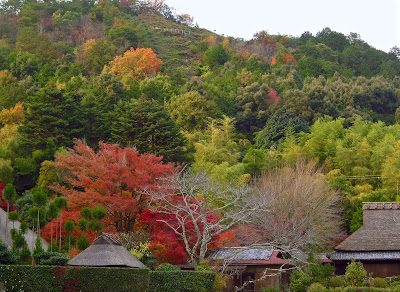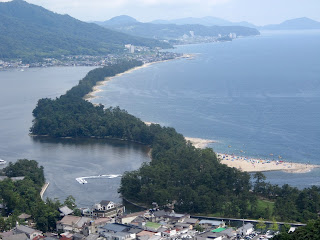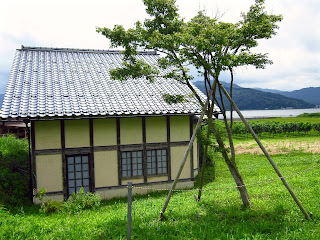It has been some time since I made a concerted effort to view the maple trees and their deciduous comrades in autumn. This is called momijigari. With very loose plans I set out to see the color show at a couple of the more remote temples in Arashiyama. This seemed to be a mistake from the moment I got off the train. Arashiyama, around Togestukyo Bridge is always swarmed with tourists. I have however successfully escaped this throng in the past. Route 29, the main road on the north side of the bridge, was almost impassable, myself and hundreds of others literally walking in the street to overtake the slower moving gawkers.
The crowd thinned beyond the Sagano Line railroad tracks. This was encouraging. I thought, keep going, keep going until you are alone. By the time I reached Sagatoriimoto in the foothills of the Atago Mountains there were just a handful of other people around.
There are two restaurants at the top of a hill where the charming Route 50 splits. Both are named for the fresh Ayu fished from the nearby Hozu River. I stopped for lunch at the one that appeared to be more modest in its pretensions - the 400-year-old Ayu no Yado Tsutaya. I was shown the menu in advance, a tactful stratagem for shooing away dusty backpackers and budget tourists, then escorted to what I had hoped would be a private washitsu.
Alas, the lovely room with its immaculate tatami and gleaming black lacquer table was occupied by what I must describe as the stiffest, most uptight bi-racial couple I have ever encountered. The gaijin was a middle-aged man with a neatly bald head and black mock-turtleneck sweater whose posture was impossibly straight. The Nihonjin (Japanese) was a spectacularly plain woman in glasses hovering on the younger side of the same age bracket. They spoke in hushed tones as if sharing government secrets. The pretence was palpable. And my nice grilled Hamo (pike conger eel) lunch was all but ruined.
I left that disagreeable scene and drifted through the mountain-hugging back streets where some truly gorgeous homes proudly sit. A wrong turn brought me to Giou-ji Temple and a large flag-following tour group. This horde dissuaded me from lingering. At the entrance to Takaguchi-dera nearby I was greeted by temple staff shouting angrily at a man taking photos outside the temple grounds. The nerves of those working in the industry serving the above mentioned millions clearly fraying. I quickly u-turned.
I headed east on a road that cut across open fields and farmland to Daikaku-ji Temple. Built some 1200 years ago this expansive structure complete with a large pond 1 kilometre in circumference was originally the detached palace of Emperor Saga (785-842). It was converted to a temple in 876. There is a network of buildings connected by squeaking covered walkways. Slippers are provided at the entrance which makes stepping into the various rooms easy, but becomes humorously problematic when you discover your slippers are gone when you step out.
The shortened days mean the tourist groups abandon their missions early. Walking back to the train through the town the earlier bustling streets were now pleasantly muted, the autumn palette of the Arashiyama hills a deeper, more moody hue. My serene momijigari - found at last.
































